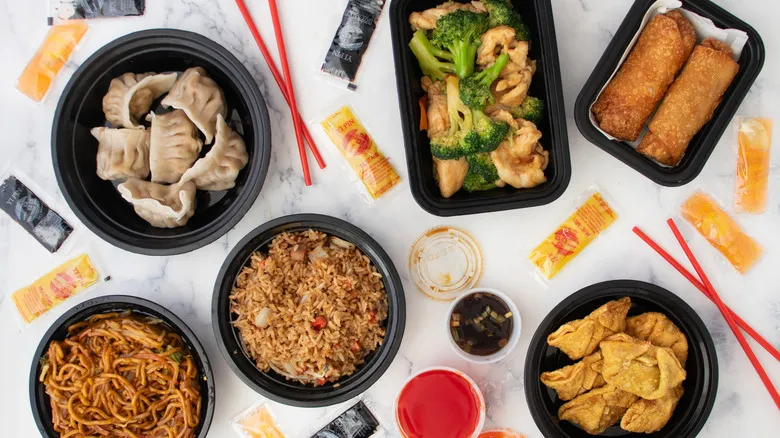Prepping leftovers for a more successful reheat
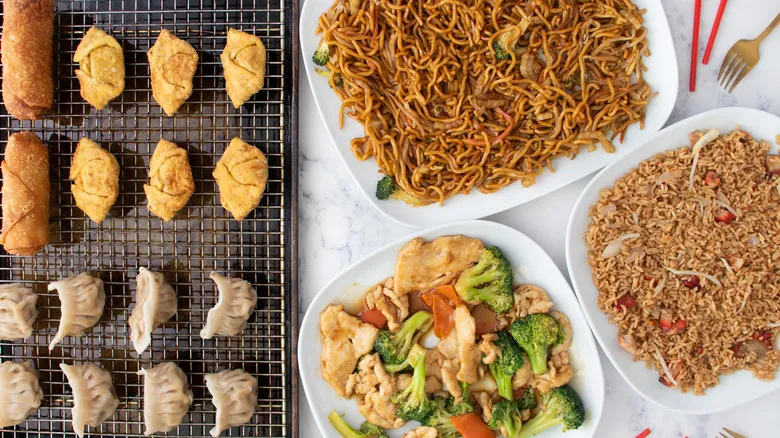
You've placed your order, enjoyed your meal, and now you're feeling quite full. But before you seal up those containers and pop them in the fridge, let’s take a moment to prepare those leftovers! You’ll be glad you did.
I want to share a culinary concept with you: carryover cooking. This refers to the phenomenon where food continues to cook even after being removed from the heat source due to residual heat. Takeout containers are designed to retain heat, keeping your food warm and cozy during the journey from the restaurant to your home. To slow down the carryover cooking, it’s important to cool your leftovers quickly—first at room temperature, then in the refrigerator.
For fried items (like egg rolls and crab rangoon) and steamed appetizers (such as steam buns and dumplings), take them out of their containers and arrange them on a wire rack. Make sure to space them out to allow air to circulate freely and cool them down. After about 15-20 minutes, once they feel cool to the touch, transfer them to a plate lined with paper towels, loosely cover them, and place them in the refrigerator.
For rice, noodles, entrees, and side dishes, remove them from their containers and spread them out evenly on a large plate or platter. Let them cool uncovered at room temperature for 15-20 minutes, or until they are cool to the touch. You can then either return the cooled items to their original containers or cover the plates or platters with plastic wrap and store them in the refrigerator.
Reviving ingredients for first-bite flavor

As our leftover Chinese food cools, its flavors can evolve over time. Occasionally, the flavors may enhance and become more complex, while at other times they might soften or taste bland. The textures can also shift, potentially drying out (which can occur with fried rice) or becoming soggy (common with noodles or delicate vegetables like broccoli, snow peas, and bell peppers). To counteract these changes, we’ll need some revitalizing ingredients to restore those initial flavors and textures.
- **Sesame oil** — used as a finishing touch, it adds a rich sesame flavor and toasty aroma.
- **Vegetable or peanut oil** — these high-heat oils are ideal for reheating on the stove.
- **Soy sauce or low-sodium soy sauce** — we’ll use soy sauce to compensate for any loss of sodium or reduction in salty taste.
- **Vegetable, chicken, or beef broth** — broths are a fantastic way to rehydrate any dried-out components.
- **Chili garlic sauce or sriracha** — these spicy condiments can easily revive flavors, invigorating both our taste buds and the ingredients.
- **Rice wine vinegar or black vinegar** — a splash or two of vinegar will restore any lost acidity.
- **Hoisin sauce or oyster sauce** — these condiments are commonly used to season saucy stir-fried dishes.
Reheating crispy appetizers
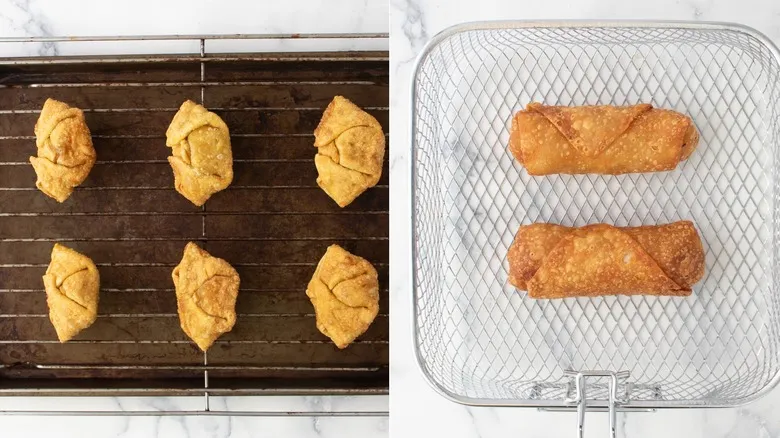
You can easily restore the crispiness of your appetizers using either an oven or an air fryer.
For reheating in the oven, arrange the appetizers on a baking sheet lined with a wire rack, ensuring they are spread out evenly without overlapping. Allow the appetizers to reach room temperature before placing them in a preheated oven at 400°F. Bake for about 12-15 minutes, depending on their size, until the internal temperature hits 165°F.
For the air fryer method, lay the appetizers in a single layer in the basket and let them come to room temperature. Preheat the air fryer to 375°F, then insert the basket and cook for 3-5 minutes, flipping them halfway through, or until they are crispy and heated through (165°F internal temperature).
If needed, you can also refresh your dipping sauces. Combine soy sauce, vinegar (either black or rice), and a small amount of chili garlic sauce or sriracha for a flavorful dip.
Reheating steamed dumplings

You can reheat steamed dumplings using either a microwave or a stove-top steamer.
To use the microwave, place the dumplings in a shallow, microwave-safe bowl, ensuring they are not touching. Add 2 tablespoons of water to the bowl and cover it with a damp paper towel. Microwave in 30-second intervals until the dumplings are hot and tender.
For the stove-top steamer method, line the bottom of the steamer basket with a small piece of parchment paper. Lightly spray the parchment and any exposed parts of the basket with cooking spray, then add the dumplings, making sure they are spaced apart to avoid sticking. Fill the bottom pot with the appropriate amount of water and bring it to a boil. Once boiling, lower the heat to medium-low and place the dumpling-filled basket on top. Cover and steam for 5-10 minutes, or until the dumplings are heated through and tender.
If needed, refresh your dipping sauces by mixing soy sauce, vinegar (either black or rice), and a small amount of chili garlic sauce or sriracha.
Reheating rice dishes
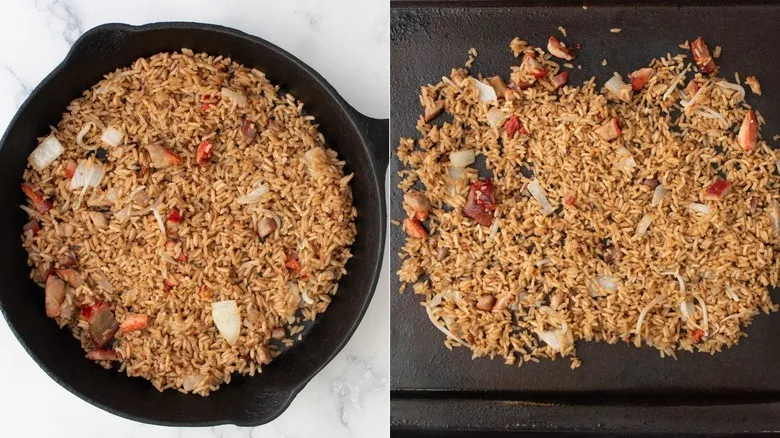
To reheat leftover fried rice, a large skillet or griddle works best.
For the skillet method, start by drizzling high-heat cooking oil into the pan and preheating it over medium-high heat. Once the pan is hot, add the fried rice, spreading it out evenly. Cook uncovered for 2 minutes. After that, stir the rice, then cover the skillet with a lid or aluminum foil, and let it cook for an additional 2-3 minutes, or until heated through. If the rice seems too dry, you can add a tablespoon of broth before covering it. Before serving, season the rice with a splash of soy sauce to taste.
For the griddle method, preheat the griddle over medium-high heat. Add a little high-heat cooking oil, and once it’s hot, spread the fried rice in an even layer. Let it cook undisturbed for 2 minutes, then drizzle a tablespoon of broth over the rice. Stir and continue cooking for another 2 minutes or until it’s heated all the way through. Before taking it off the griddle, add a dash of soy sauce to taste.
Reheating noodle dishes
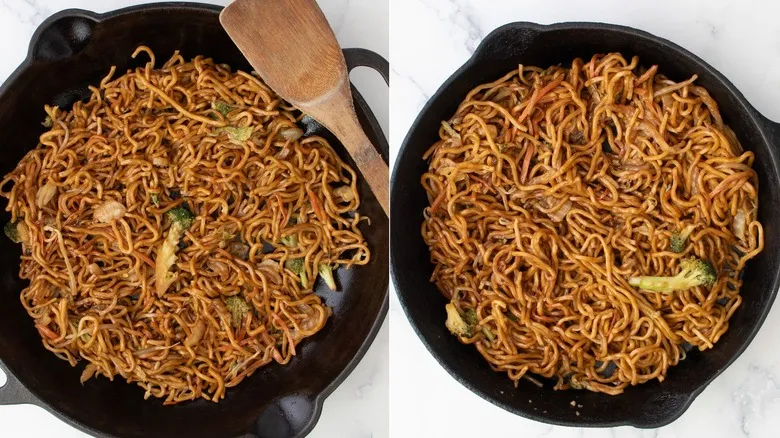
Noodle dishes, such as lo mein, are best reheated in a large skillet or wok.
To reheat in either a skillet or wok, start by drizzling the pan with high-heat cooking oil and preheating it over medium-high heat. Once the pan is hot, add the noodles and stir-fry for about 3 minutes. Season the noodles with a splash of vinegar, a bit of broth, and a small spoonful of oyster sauce or hoisin, tossing to combine. Cook for an additional minute, taste the noodles, and adjust the seasoning with more vinegar, broth, or oyster sauce as needed. Ensure the noodles are heated thoroughly before serving.
If your noodles include delicate vegetables (like broccoli, snow peas, or snap peas), consider removing them from the pan and setting them aside until the last minute of reheating. This will help prevent overcooking those delicious veggies!
Reheating stir-fried entrees

There are three effective methods to reheat your stir-fried leftovers: using a large skillet, a wok, or the oven.
For the skillet or wok method, start by adding a splash of broth and a spoonful of oyster sauce or hoisin to the pan. Heat it over medium-high until it simmers. Once simmering, incorporate the leftovers and sauté or stir-fry for about 3 minutes, or until they are heated through. Before serving, enhance the flavor with a drizzle of sesame oil and a few drops of sriracha or chili garlic sauce if you enjoy a bit of heat.
If you prefer to use the oven—especially useful for larger portions—lightly coat a baking sheet or casserole dish with cooking spray. Spread the leftovers in an even layer. In a small bowl, mix together some broth and oyster sauce or hoisin, then pour this mixture over the leftovers. Cover the dish with aluminum foil and place it in a preheated oven at 350°F. Bake for 15 minutes, stirring halfway through, until everything is heated thoroughly. Before serving, finish with a drizzle of sesame oil and a couple of drops of sriracha or chili garlic sauce for an extra kick.
Getting creative with your Chinese takeout leftovers
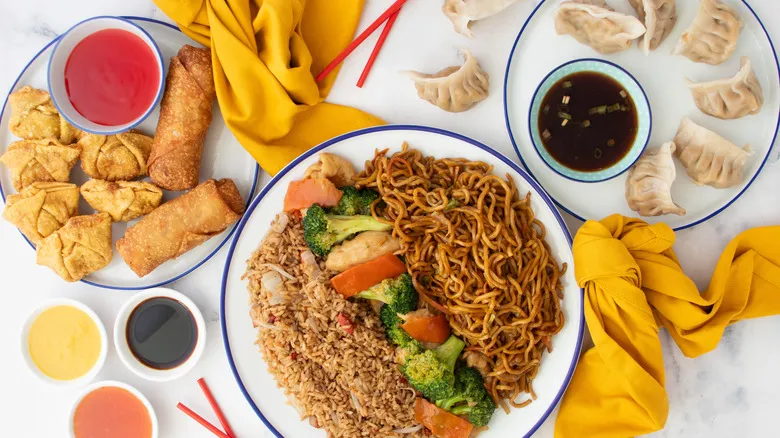
If you're looking to transform your leftovers into entirely new meals or find creative ways to use leftover Chinese takeout, I have a few personal favorites to share. One of my go-to options is making an omelet filled with leftover fried rice, omurice style. I particularly enjoy adding a slice or two of American cheese inside the omelet and finishing it off with a generous drizzle of yum-yum sauce or ketchup. It's absolutely delicious!
Leftover beef stir-fries, such as pepper steak, Szechuan beef, or Mongolian beef, can be turned into mouthwatering quesadillas or loaded grilled cheese sandwiches. Dishes like Kung Pao chicken, Szechuan chicken, or spicier stir-fried chicken (especially those with fewer vegetables) are fantastic for creating Asian-inspired nachos or tacos. These protein-rich, chicken-based leftovers also work wonderfully in lettuce wraps.
Plain white rice is perfect for crafting rice-based soups or stews. I particularly enjoy making chicken and rice soup with leftover takeout white rice. If you're a fan of congee, leftover white rice serves as an excellent base.
As a friendly reminder, whether you're reheating for that first bite of flavor or remixing into exciting new dishes, be sure to enjoy your leftovers within 3 to 4 days. Remember to refrigerate them after allowing them to cool briefly at room temperature, and always reheat to a temperature above the danger zone (140°F or higher).
Recommended

The Easy Way To Remove The Tendon From Raw Chicken
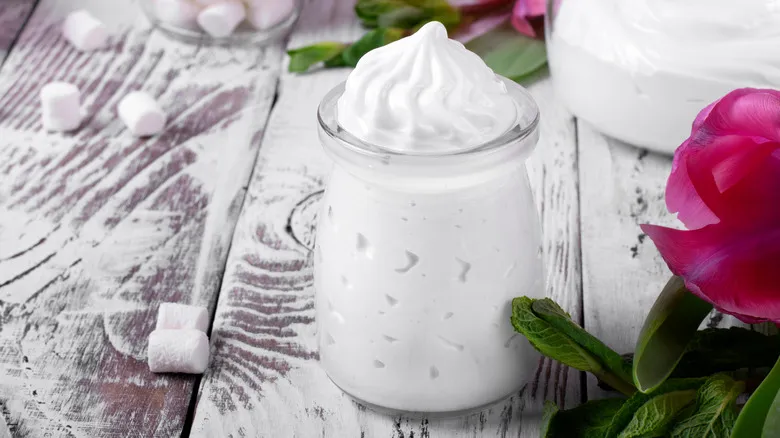
The Only 2 Ingredients You Need For Easy Marshmallow Fluff
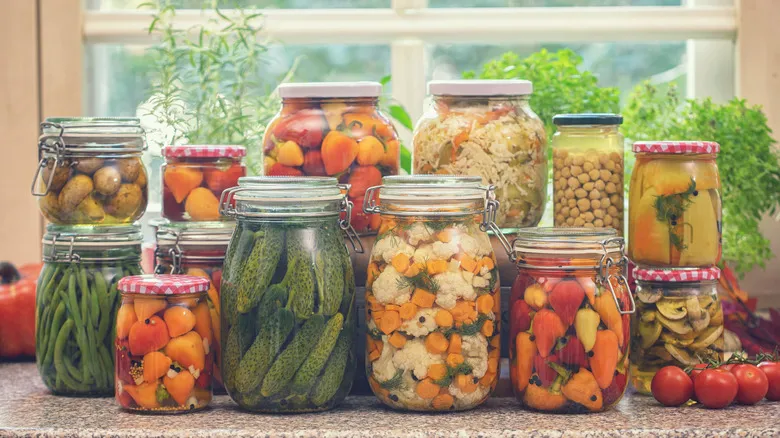
The Tell-Tale Signs Your Home-Canned Goods Have Spoiled
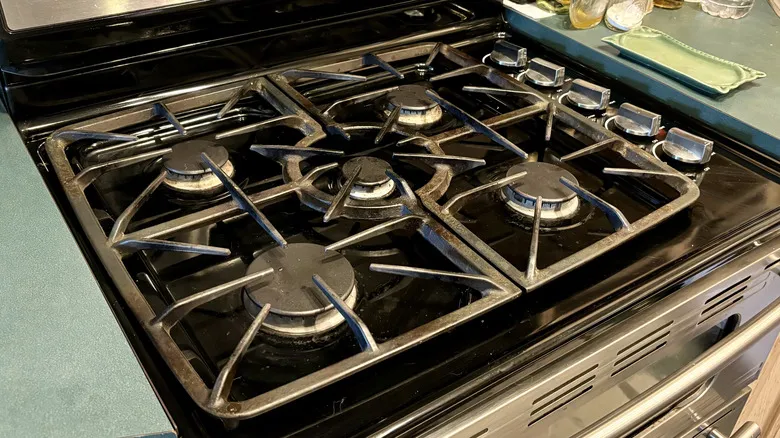
How To Clean And Care For Gas Stove Grates
Next up

